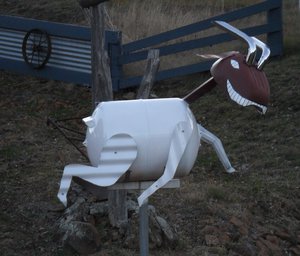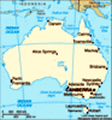Advertisement

 Funny Clever Letter Boxes
Funny Clever Letter Boxes
This one is made from an empty gas cylinder, corrugated steel, some kind of tray and two chrome exhaust pipesToday we wanted to see the Siding Spring Observatory just on the edge of the Warrumbungle National Park. As we drove along the road leading there we kept noticing some very unusual and imaginative letter boxes. I managed to get Barry to slow down to let me photograph a few of them. They included a little dunny with a spider on the front; a big yellow bird; a dog standing to attention with his rifle on his shoulder and saluting; a rather rusty Ned Kelly; and a complete very shiny wheel with red rims (not sure where the mail goes); a grinning goat and more. We also found the rest of the planets from “The World’s Largest Virtual Solar System Drive” finishing with the sun which is the dome of the main telescope.
There are 13 telescopes, owned by a number of different countries and organisations, operating on the land which is owned by the Australian National University. One of the telescope owners is Google, who rents out the time for anyone who wants to search the sky to, for example, look for asteroids or comets, or as part of school curricula.
The largest telescope on site is jointly

 Siding Spring Observatory, Education Centre
Siding Spring Observatory, Education Centre
Barry trying to lift a one litre carton as if it is what it would weigh on the Sun and barely managing to raise a corner.British and Australian, the 3.9 metre Astronomical Observatory. The Education Centre is located just below it and is full of well presented information, including hands-on displays, like a push button model of the relative speeds and position of the planets circling the sun, and a scale which you stand on and tells you what you would weigh on other planets. I would be 35 kilos on Mars (I like that one) and 2.2 tonnes on the Sun! You could also try and pick up a litre of milk as it would be on each planet to compare them. The sun one was so heavy Barry could barely lift it even a centimetre.
We also learned that the telescope itself could be fitted with three pieces of equipment that each focus the light differently so that the moon would appear to be 11.5cm from one, 28 or 52cm from the second, which has 2 focal possibilities, and 125cm from the last, depending on what the scientists want to observe.
By this time we were getting hungry so we treated ourselves to lunch, a lovely toasted salmon and avocado sandwich for me and a thickly sliced beef and onion one

 Siding Spring Observatory
Siding Spring Observatory
The optical telescope in the main dome. We saw this from inside and got to watch it swinging around and the dome moving, while being re-aligned. for Barry, with coffees.
We then climbed the steps up to the big telescope and went into the glass public gallery where we could see the whole mechanism and dome. As I was taking photos, we noticed a man coming down from an upper level. Imagine our surprise when he opened the door to the gallery and asked if we would like to come inside and have a tour of the facility! Another couple arrived just in time to join us. It was absolutely brilliant to have a knowledgeable and interesting person tell us the inside story. He explained the technical things but also the human side. Turned out that he is responsible for all the electrics as the only Electrical Technician on site (there are several other types of technicians).
He told us how sensitive the equipment is and how easily it can be interfered with. It can see a very wide range of light frequencies, including infra-red. One day the scientists found that there was an infra red signal that shouldn’t be in the dome. After searching everywhere, the technicians discovered that someone had left a replacement battery with an LED light on it lying around.

 Siding Spring Observatory
Siding Spring Observatory
Our wonderful guide showed as the Control Room and equipment. He moved the dome and telescope from this console.They had put some duct tape over the LED, which would normally stop it interfering, but the tape had a tiny crease in it and the signal was coming out through the minute gap it created!
We went up in a lift to the area where the control room is and the door out to the balcony that runs all around the outside. The view from the balcony was wonderful (though very cold) and we could see many of the mountains’ rocky shapes, as well as the other telescopes and the cabins where some of the staff live. He told us that he had been living there when the huge bushfires came in January 2013 and he left it rather late to leave on his motorbike so he nearly got trapped as he tried to get off the mountain. Many buildings were destroyed, including the fire station itself so the fire engines now sit on the concrete slab that used to be their home. His boss came back after the fire to find his car port had been flattened (not burned) by the water bombing! The big telescope itself was not touched and since then it has been designated

 Warrumbungle National Park
Warrumbungle National Park
The strange shapes are the remains of the core of a volcano that has eroded away leaving the plug.as a safe place to take refuge in a fire rather than trying to escape it.
He also showed us the control room and then we stood under the dome and watched as he re-aligned the dome and swung the telescope ready for the evening. It moved quite quickly and very smoothly and quietly. Marvellous – we were so lucky.
After we’d finished at the observatory, we headed into the National Park. We wanted to check out the Camp Blackman and look at some of the rock formations. All the weird and wonderful shapes of the rocky spires and domes are the hard plug remnants of the weathering on a large shield volcano that was active 13 million years ago. Whitegum Lookout gave us a really good view of Bluff Mountain and its smaller neighbour Bluff Pyramid (which has quite defined edges), Belgourey Spire (with its square top), Belgourey Split Rock (which looked more like someone had taken a bite out instead of a split) and the 90 metre high Breadknife (which is very skinny and has a sharp edge – it looked very small from that distance when compared to the other formations – maybe up closer

 Warrumbungle National Park
Warrumbungle National Park
At Whitegum Lookout we saw a lot of trees still trying to recover from the January 2013 bushfires that devastated the area. These "long hairy" trees are now growing leaves from new twigs wherever the tree is still alive, including all over the trunk.it is more impressive).
As we walked along the path to the lookout we could see all the damage from the bush fire, which had been so hot that some of the trunks of the dead trees were charcoal all through. The tops of many of the trees were still dead but, amazingly, most were growing prolifically from the trunks and lower branches. The Australian bush is remarkable. The trees send out leaves on tiny stems directly from any part of the tree that is still alive, especially the trunk, so that it can quickly get more energy for recovery (which looks very funny – like green hair all over it). A year and a half on, these had now grown so that they had thin twigs with leaves growing from them in a more normal manner (which looked like longer hair!). Eventually these will become the new branches. The ground was completely covered with young trees grown from the seeds that had been opened in the heat of the fire. They were far too densely packed but natural thinning occurs when the ones that grow fastest will, in the future, block the light from the smaller ones and

 Warrumbungle National Park
Warrumbungle National Park
Along the path to the Whitegum Lookout we could see how fierce the fires must have been to turn this tree, and others, into charcoal. Amazingly, masses of new trees are now growing up next to the dead parent trees.they will die.
There were also quite a few small native flowers and grasses growing well. The sad part was the road sign saying to watch out for koalas. Most would have been killed in the fires as, unlike kangaroos, they can’t get away. We certainly didn’t see any.
We did see quite a few Eastern Grey Kangaroos, especially around Camp Blackman, which was great (except we had to slow down as they tend to startle and jump in front of the car to get away).
On the way back to Coonabarabran we stopped at a couple more of the wonderful letterboxes so I could take photos. Then I did some shopping and we bought the fish and chips I suddenly had a yen for.
What a lovely, unexpected day!
Advertisement
Tot: 0.065s; Tpl: 0.012s; cc: 14; qc: 30; dbt: 0.0339s; 1; m:domysql w:travelblog (10.17.0.13); sld: 1;
; mem: 1.1mb









Snap Shot Stacey
Snap Shot Stacey
Clever!
What a great way of showing the differences! Wish I could have tried it.